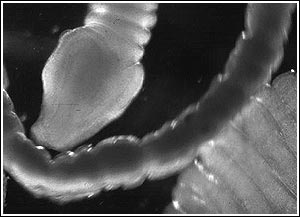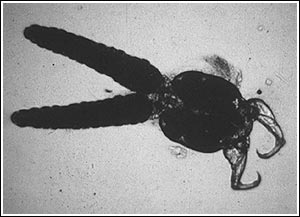

 |
||||||||||||
 |
||||||||||||
| Introduction to Freshwater Fish Parasites | ||||||
| Page 12 of 14 | Pages: 1 . 2 . 3 . 4 . 5 . 6 . 7 . 8 . 9 . 10 . 11 . 12 . 13 . 14 | |||||
CESTODES Cestodes, also called tapeworms, are found in a wide variety of animals, including fish ( Figure 23 ). The life cycle of Cestodes is extremely varied with fish used as the primary or intermediate host. Cestodes infect the alimentary tract, muscle or other internal organs. Larval Cestodes called plerocercoids are some of the most damaging parasites to freshwater fish. Plerocercoids decrease carcass value if present in muscle, and impair reproduction when they infect gonadal tissue. Problems also occur when the cestode damages vital organs such as the brain, eye or heart.  Figure 23: A close-up of a tapeworm.
Figure 23: A close-up of a tapeworm.
One of the most serious adult Cestodes that affect fish is the Asian tapeworm, Bothriocephalus acheilognathi . It has been introduced to the United States with grass carp and has caused serious problems with bait minnow producers. Praziquantel at 2 -- 10 mg/L for 1 to 3 hours in a bath is effective in treating adult cestode infections in ornamental fish. At this time, there is no treatment that can be used for food fish. Also, there is no successful treatment for plerocercoids. Ponds can be disinfected to eradicate the intermediate host, the copepod. PARASITIC CRUSTACEA Parasitic crustacea are increasingly serious problems in cultured fish and can impact wild populations. Most parasitic crustacea of freshwater fish can be seen with the naked eye as they attach to the gills, body and fins of the host. Three major genera are discussed below. Ergasilus Ergasilus ( Figure 24 ) are often incidental findings on wild or pond-raised fish and probably cause few problems in small numbers. However, their feeding activity causes severe focal damage and heavy infestations can be debilitating. Most affect the gills of freshwater fish, commonly seen in warm weather. A 3% salt dip, followed by 0.2 %-prolonged bath for three weeks, may be effective in eliminating this parasite.  Figure 24: A close-up of an Ergasilus
Figure 24: A close-up of an Ergasilus
more ... |
 |
|||||
| About Us :: Message Board :: Chat | |||||
| Library :: Photo Gallery :: Links & Resources :: Breeders & Sponsors :: Merchandise | |||||
| Website designed by: EthanCote.com | © 2001-2004, SimplyDiscus.com. All Rights Reserved. | ||||